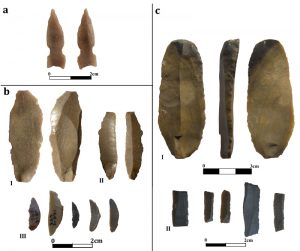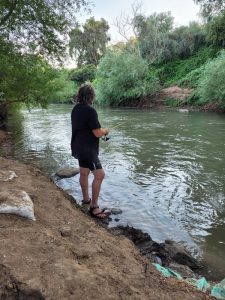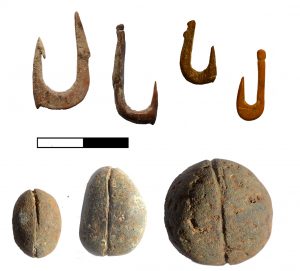The study of the JRD flint assemblage is in its early stages. Nevertheless, a few preliminary observations can be presented. A sample of 2,101 artifacts from all JRD archaeological layers, except Layer 6, has been studied thus far. Unlike most EP sites in the Mediterranean Levant, the density of artifacts in all archaeological horizons at JRD is low. This is likely related to the short-term, task-specific nature of the JRD occupation. The best represented category of debitage in the flint assemblage is flakes, but blades and bladelets are also well represented in all layers. The presence of core trimming elements (CTEs) and primary flakes suggest that at least some of the stone tools in every layer were manufactured on site.
A preliminary typological analysis of the lithic assemblages demonstrates that at least three EP cultures are represented at JRD. The three upper layers 3a, 3b and 3c are ascribed to the Late EP Natufian culture due to the presence of diagnostic lunates and small sickle blades with un-worked edges. Layer 4 yielded trapeze-rectangle microliths and end-scrapers, mostly shaped from blade blanks — these are typical of the Middle EP Geometric Kebaran culture. No clear culturally diagnostic traits have been observed in the Layer 5 assemblage to date, yet the absence of geometric microliths and the presence of narrow-fronted bladelet cores suggest an Early EP affiliation for this assemblage. In addition, the presence of microburins in Layer 5 suggests that this assemblage should not be attributed to the Kebaran or Geometric Kebaran traditions. Instead, the notable presence of carinated scrapers hints at an Early EP Masraqan affiliation. Carinated items are difficult to definitively categorize as cores or scrapers (Belfer-Cohen and Grosman 2007). Most of the items in this class from JRD are typologically described as broad (31%) or narrow (27%) carinated scrapers. Other relevant types a shouldered/nosed scrapers (15%) and core-scrapers (15%). Lateral carinated scrapers are rare. Thus, each of the three chronological phases of the EP (Early, Middle and Late) are represented in the JRD sequence. Interestingly, an el-Khiam point, diagnostic of the Early Neolithic Khiamian culture, was also unearthed in Layer 3a, suggesting that the use of JRD probably extended beyond the Epipaleolithic into the Neolithic.

High frequencies of burins are present in layers 3c, 4 and 5, but they are rare in Layer 3a. Such exceptional percentages of burins hint that a specific activity was executed at the site, possibly related to the acquisition of aquatic resources. The size of the Layer 5 burin assemblage is sufficient to present preliminary frequencies of the types represented. Burins on the break or natural surface (38%) and burins on notch or truncation (30%) are by far the best represented. Among the latter, the most frequent sub-types are burins on concave (8%) and straight truncations (7%). Dihedral burins are also represented (12%). Sickle blades, mostly of the unretouched or curved-backed variety, are present in all layers, except Layer 5. Finally, perforators and notches/denticulates are well represented in layers 3a and 5.
Future technological analysis of the JRD assemblage will provide a more detailed picture of the cultural and functional aspects of the occupations and the reduction sequences (chaînes opératoire) used to produce tools. To date, preliminary observations suggest that many tools were manufactured on byproducts of reduction (CTEs and primary flakes) rather than on ‘formal’ blanks. Some tools were also recycled for new purposes. Currently, it is difficult to connect the lithic assemblages to a specific set of tasks; although the quantities are small, a large repertoire of tool types is represented. Still, the unusually high incidence of burins in layers 3c, 4 and 5 suggests continuity in the activities performed across the long sequence of repeated occupations.

